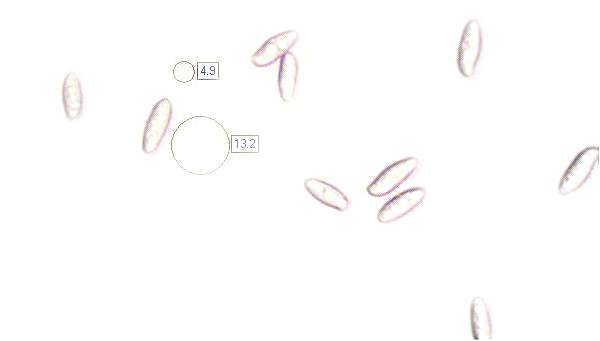Boletus aereus Bull. ex Fr. - Bronze Bolete
Phylum: Basidiomycota - Class: Agaricomycetes - Order: Boletales - Family: Boletaceae
Distribution - Taxonomic History- Etymology - Identification - Culinary Notes - Reference Sources
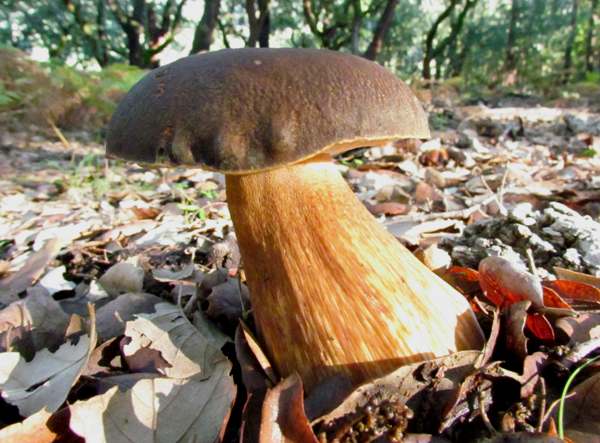
Boletus aereus, referred to by some as the Queen Bolete but recently given the common name Bronze Bolete in Britain and Ireland, is a most sought-after edible mushroom. It is just as good as its famous close relative, Boletus edulis (Cep or Penny Bun Bolete) but its flesh is rather firmer. In the street markets of France, for example, these excellent boletes are sold together with Boletus edulis and Boletus reticulatus, and customers are equally delighted with whichever of these meaty mushroom species is available.
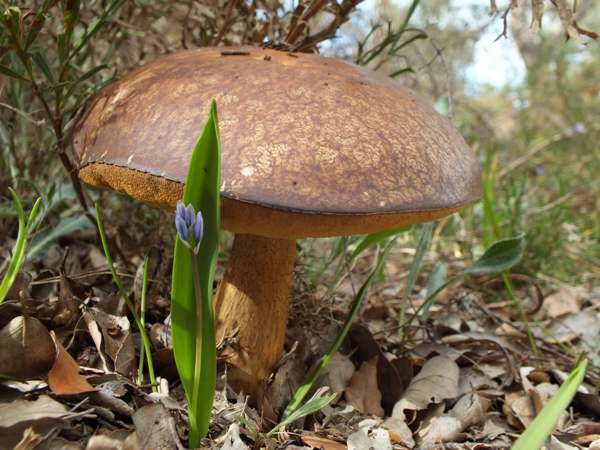
Distribution
A rare find in Britain and Ireland, where it is mainly confined to southern parts, Boletus aereus is much more common in southern Europe.
Commonly found at the edges, beside walks or in clearings in oak and beech woodlands, Boletus aereus tends to fruit a little later than Boletus edulis, which in turn appears somewhat later than the Summer Bolete, Boletus reticulatus.
Most boletes, and certainly all of the common ones found in Britain and Ireland, are ectomycorrhizal fungi. This means that they form mutualistic relationships with the root systems of trees or shrubs. The fungi help the tree to obtain moisture and vital minerals from the soil, and in return the root system of the tree delivers energy-rich nutrients, the products of photosynthesis, to the fungal mycelium.
Although most trees can survive without their mycorrhizal partners, boletes (and many other kinds of forest-floor fungi) cannot survive without trees; consequently these so-called 'obligately mycorrhizal' fungi do not occur in open grassland.
Taxonomic history
The scientific name Boletus aerus originated in Jean Baptiste Francois Pierre Bulliard's 1789 descriotipon of this species. Synonyms of Boletus aereus includeBoletus mamorensis Redeuilh
Etymology
The generic name Boletus comes from the Greek bolos, meaning lump of clay; the origin of the specific epithet aereus is Latin and means copper or bronze (in colour) - hence the common name Bronze Bolete. Some people refer to it as the Black Porcini or the Black Cap Bolete.
Identification guide
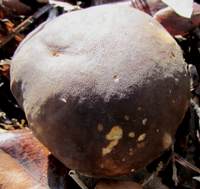 |
CapInitially downy but soon becoming smooth with a finely cracked or granular surface, the dark-brown to dark sepia-brown caps of Boletus aereus range from 7 to 20cm diameter at maturity. The cap margin is often a more reddish brown than the centre. When cut, the cap flesh usually remains white or very slowly turns slightly purplish. |
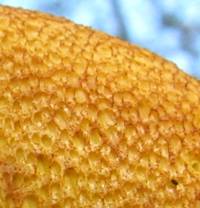 |
Tubes and PoresThe tubes of Boletus aereus (seen when the cap is broken or sliced) are white or pale cream, becoming bright sulphur yellow at maturity; they terminate in very small creamy white pores that become rust-coloured (see left) with age. When cut or bruised, the pores and tubes of Boletus aereus do not change colour rapidly, but after a time they develop a vinaceous tinge. |
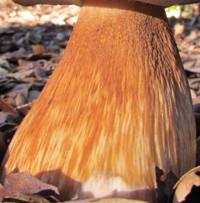 |
StemA fine brown net pattern (reticulum) is visible on the pale brown background of the stem surface, darkest towards the apex and at the base and usually somewhat paler and pinker near the swollen centre of the stem. Occasionally clavate (club-shaped) but more often barrel-shaped, the stem of Boletus aereus is 5 to 12cm tall and up to 8cm in diameter at its widest point. The stem flesh is white and very firm. |
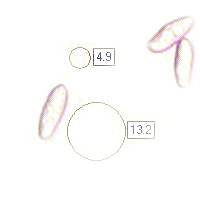 |
SporesSubfusiform, smooth, 13-16 x 4-5.5μm. Spore printOlive-brown. |
Odour/taste |
Boletus aereus has an earthy smell and a pleasant mild taste. |
Habitat & Ecological role |
Boletus aereus grows on soil beneath broadleaf trees, notably Beech and oaks. |
Season |
August to October in Britain and Ireland, this bolete can be found from October through to February in some parts of southern Europe. |
Similar species |
Boletus edulis has a pale stem with a white reticulum; its brown cap has a whitish marginal region. Tylopilus felleus has a darker stem reticulum and a pinkish tinge to its pores; it has a very bitter taste. |
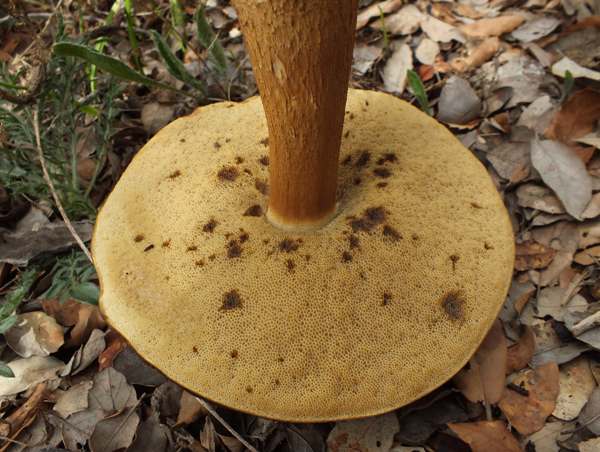
Above: This spring-fruiting Algarve bolete looks rather like Boletus badius, the Bay Bolete, but when bruised its pores do not turn blue. The faint reticle on the stem is another clue to its true identity - Boletus aereus.
Culinary Notes
Use Boletus aereus in any reccipe where Ceps (Boletus edulis) are called for, as these are two of the world's finest edible fungi and their texture and taste are almost identical.
In the book Fascinated by Fungi (see the sidebar on this page for brief details and a link to full information, reviews etc) there is a good selection of magnificent mushroom menus all based on our 'Magnificent Seven', and Boletus edulis is, of course, one of the seven; substituting Boletus aereus in no way detracts from the excellence of a meal.
If you want to improve your chances of finding the best edible boletes, it helps a great deal if you look in the right kinds of places and under the trees that these magnificent mushrooms are most commonly linked to. There is a lot more information on this topic, including chapters detailing which fungi species are obligately mycorrhizal and the kinds of tree each is associated with, in Fascinated by Fungi.
Reference Sources
Fascinated by Fungi, 2nd Edition, Pat O'Reilly 2016, reprinted by Coch-y-bonddu Books in 2022.
Geoffrey Kibby (2012) British Boletes, with keys to species, 3rd Edition ,
Roy Watling & Hills, A.E. (2005). Boletes and their allies (revised and enlarged edition), - in: Henderson, D.M., Orton, P.D. & Watling, R. [eds]. British Fungus Flora. Agarics and boleti. Vol. 1. Royal Botanic Garden, Edinburgh.
BMS List of English Names for Fungi
Paul M. Kirk, Paul F. Cannon, David W. Minter and J. A. Stalpers, (2008); Dictionary of the Fungi;CABI,
Taxonomic history and synonym information on these pages is drawn from many sources but in particular from the British Mycological Society's GB Checklist of Fungi.
Fascinated by Fungi. Back by popular demand, Pat O'Reilly's best-selling 450-page hardback book is available now. The latest second edition was republished with a sparkling new cover design in September 2022 by Coch-y-Bonddu Books. Full details and copies are available from the publisher's online bookshop...
